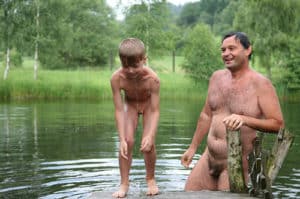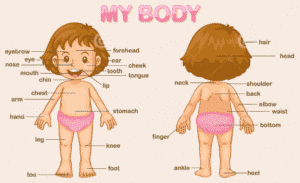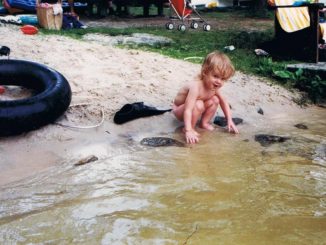Is Nudism, and Family Nudity Good for Children? Aren’t Kids Nudists Anyway?
Is Nudism Good for Children and The Truth Behind Nudity in the Family:
Guest blog by: Melissa Starr
Benjamin Spock, Ann Landers, and Abigail van Buren, all popular authorities on child-rearing and other matters, have often warned of the dangers of exposing children to nudity. Though their theories on the matter are well-known, are they truly valid? Is there solid research to prove it? Studies of how nudity affects kids are actually sparse, though they have slightly increased in number in recent years.
The findings and their interpretations are often influenced by researchers’ own preconceptions, including findings that may better explain the effects of parents’ attitudes toward nudity on kids rather than the actual effect of children being exposed to nudity.
However since the late 1970’s, more objective and controlled research has taken place in an effort to identify the truth of how exposure to nudity affects child development. All of this nudism research indicates not only a lack of negative effects, but a whole list of benefits to children.
One of the first truly objective studies was developed by Dr. Marilyn Story, a researcher who sought to examine the role of family social nudity classification on body self-concept development in preschool-aged children. Dr. Story interviewed 264 children aged three to five years as well as their parents. The children were classified in one of three categories: social naturists or simply put – nudist kids, at-home nudist, and non-nudist kids.

Each child was interviewed individually as they were asked about their body parts, namely whether they like each of the 16 body parts discussed. Within this study, a correlation was identified between gender and which body parts were most desirable.
The study also found that non-nudist kids most often identified their genitals as their least-liked body parts. Adversely, nudist kids (which basically means – children from nudist homes) identified their genitals as their most-liked body parts and identified no parts of their body that they liked the least. Within this study, naturism / nudism was found to be a more important variable than gender, race, and geographical area in terms of having a positive self-concept, body acceptance, and self-image.

Another important study was conducted by Ron and Juliette Goldman in 1981 to examine children’s perception of clothing and nakedness in regard to modesty in four different locations: North America, England, Australia, and Sweden. Within this study, children aged five to fifteen were studied, and research centered on children’s perceptions of the need for clothing in different circumstances as well as the reason given for the need for clothing.
Though the study was intended to determine which societies were most insistent on wearing clothes for the purpose of modesty, this study determined that children’s perceptions of nakedness was strongly tinged with guilt. As they aged they conformed more to their parents’ modesty training, thereby causing children’s guilt about nakedness to increase with age. Such guilt was found in children who did not understand, accept, or enjoy their body and its sex organs as natural and normal.
Robin Lewis and Louis Janda conducted a study in 1998 to examine the relationship between adult sexual adjustment and childhood exposure to nudity, sleeping in the parental bed, and parental attitudes toward sexuality. These components had mixed results in previous studies, which necessitated further research. Lewis and Janda used an extensive questionnaire to survey 210 undergraduate university students about their childhood experiences with nudity.

The results of the study were clear: there is a positive relationship between childhood exposure to nudity and adult sexual comfort. Further, the study found that children from birth to age five who were exposed to nudity felt less discomfort with affection and physical contact as they grew older. Children ages 6-11 who were exposed to nudity (i.e. nudist kids ) had greater self-esteem and knowledge about sex.
Margaret Mead is an anthropologist who has completed many studies on the effects of nudity on children and is one of the most well-known researchers on this topic. Dr. Mead studied cultures throughout the world and noted many negative effects that clothing had in the western culture’s clothing-dependent society.

These effects include a separation of “self” from the “body,” a lack of point of comparison for all body parts due to clothing covering them, a preoccupation with sex that is emphasized through clothing, and a lack of education about the human body related to lack of exposure to it. She further identified that the nudity or partial nudity common to more primitive cultures was not an indication of a lack of modesty, and the way nudity is handled within a culture is more important than the presence of nudity in determining whether it will have negative effects. One area that she emphasizes is that a child must see nudity among adults so that they know what their body will become; this is essential to the developing person.
One common theme throughout the research was the effect of the family’s and society’s attitude about nudity on children. The presence of a positive or negative attitude towards nudity was far more important than any other factor in nearly every situation when it came to how a child would react to nudity around them. These studies show that not only is nudity not harmful to children (sorry Dr. Spock), but that they can benefit in various ways from exposure to nudity in a body-positive, accepting environment.
Children can gain increased knowledge and understanding of the human body in all of its forms along with greater comfort with sexuality and physical contact as they grow older. They also learn to accept their own bodies and have greater self-esteem. Thus it is really up to us as parents, as educators, as individuals, as a society, to adopt a more open and accepting view of nudity for children to benefit.
This nudist family article was originally published on May 20, 2012.



